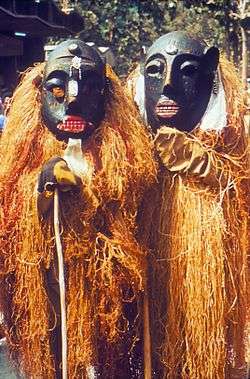Witch doctor

A witch doctor was originally a type of healer who treated ailments believed to be caused by witchcraft.[1] The term witch doctor is sometimes used to refer to healers, particularly in third world regions, who use traditional healing rather than contemporary medicine. In contemporary society, "witch doctor" is sometimes used derisively to refer to chiropractors, homeopaths and faith healers.
Original meaning of the term
In its original meaning, witch doctors were emphatically not witches themselves, but rather people who had remedies to protect others against witchcraft. Witchcraft-induced conditions were their area of expertise, as described in this 1858 news report from England:[2]
Recourse was had by the girl's parents to a cunning man, named Burrell, residing at Copford, who has long borne the name of "The Wizard of the North:" but her case was of so peculiar a character as to baffle his skill to dissolve the spell, Application was next made to a witch doctor named Murrell, residing at Hadleigh, Essex, who undertook to effect a cure, giving a bottle of medication, for which he did not forget to charge 3s. 6d., and promising to pay a visit on Monday evening to the "old witch," Mrs. Mole, and put an end to her subtle arts... ... the news of the expected coming of the witch-doctor spread far and wide, and about eight o'clock there could not have been less than 200 people collected near the cottage of Mrs. Mole to witness the supernatural powers of the Hadleigh wizard.
In Europe
The Oxford English Dictionary states that the first record of the use of this term was in 1718, in a book by Francis Hutchinson.[3]
Charles Mackay's book, Extraordinary Popular Delusions and the Madness of Crowds, first published in 1841, attests to the practice of belief in witch doctors in England at the time.
In the north of England, the superstition lingers to an almost inconceivable extent. Lancashire abounds with witch-doctors, a set of quacks, who pretend to cure diseases inflicted by the devil. The practices of these worthies may be judged of by the following case, reported in the "Hertford Reformer," of the 23rd of June, 1838. The witch-doctor alluded to is better known by the name of the cunning man, and has a large practice in the counties of Lincoln and Nottingham. According to the writer in "The Reformer," the dupe, whose name is not mentioned, had been for about two years afflicted with a painful abscess, and had been prescribed for without relief by more than one medical gentleman. He was urged by some of his friends, not only in his own village, but in neighbouring ones, to consult the witch-doctor, as they were convinced he was under some evil influence. He agreed, and sent his wife to the cunning man, who lived in New Saint Swithin's, in Lincoln. She was informed by this ignorant impostor that her husband's disorder was an infliction of the devil, occasioned by his next-door neighbours, who had made use of certain charms for that purpose. From the description he gave of the process, it appears to be the same as that employed by Dr. Fian and Gellie Duncan, to work woe upon King James. He stated that the neighbours, instigated by a witch, whom he pointed out, took some wax, and moulded it before the fire into the form of her husband, as near as they could represent him; they then pierced the image with pins on all sides – repeated the Lord's Prayer backwards, and offered prayers to the devil that he would fix his stings into the person whom that figure represented, in like manner as they pierced it with pins. To counteract the effects of this diabolical process, the witch-doctor prescribed a certain medicine, and a charm to be worn next the body, on that part where the disease principally lay. The patient was to repeat the 109th and 119th Psalms every day, or the cure would not be effectual. The fee which he claimed for this advice was a guinea.
In Africa
In southern Africa, the witch doctors are known as sangomas. The Oxford English Dictionary states that the first use of the term "witch doctor" to refer to African shamans (i.e. medicine men) was in 1836 in a book by Robert Montgomery Martin.[4]
BBC News reported, on March 12, 2015, that, "More than 200 witchdoctors and traditional healers have been arrested in Tanzania in a crackdown on the murder of albino people. The killings have been driven by the belief – advanced by some witchdoctors – that the body parts have properties that confer wealth and good luck. According to the Red Cross, witchdoctors are prepared to pay $75,000 (£50,000) for a complete set of albino body parts. Nearly 80 albino Tanzanians have been killed since 2000, the UN says. The latest victims include a one-year-old albino boy, killed in north-western Tanzania a few weeks ago. The government banned witchdoctors in January as part of its efforts to prevent further attacks and kidnappings targeting people with albinism."[5]
See also
- Bomoh
- Curandero
- Medicine man (indigenous peoples of the Americas)
- N'anga
- Nganga
- Plastic shaman
- Quimbanda
- Sangoma
- Shaman
References
- ↑ Lugira, Aloysius Muzzanganda. African Traditional Religion, p. 100 (Infobase Publishing, 2009).
- ↑ The Ipswich Journal (Ipswich, England), Saturday, September 25, 1858.
- ↑ Hutchinson, Francis (1718). An Historical Essay concerning Witchcraft. London: Printed for R. Knaplock and D. Midwinter.
- ↑ Martin, Robert Montgomery (1836). History of Southern Africa comprising the Cape of Good Hope, Mauritius, Seychelles, &c. London: J. Mortimer.
- ↑ "Tanzania albino murders: 'More than 200 witchdoctors' arrested". BBC News. 12 March 2015.
Further reading
- Maxell, Nicole (1990) Witch Doctor's Apprentice. New York: Citadel Press. ISBN 0-8065-1174-5; ISBN 978-0-8065-1174-0
.jpg)